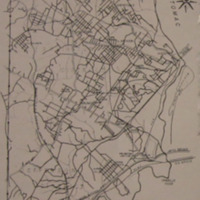Browse Items (7 items total)
In 1915 and 1929 Arlington County lost land to Alexandria City. Though the county and city provided consistent amenities at the time, including road, water, sewer, and education, the city successfully argued that they were better equipped to handle the rapidly growing environment of suburban Arlington. As a result Arlington lost over 3,000 acres.
In 1930 and 1938 two laws were passed to prevent Arlington from losing more land.
In 1930 and 1938 two laws were passed to prevent Arlington from losing more land.
Collection: Maps
This map shows each of the electric railways lines and stops within Arlington County from 1892 through 1941. It helps to show the increased connectivity of county residents to Washington and within the county. Trolley growth helped to encourage continued suburbanization and community development throughout Arlington in the late nineteenth and early twentieth centuries.
By 1924 Arlington's electric railway lines provided 64 stops within the County, 28 stops to destinations further north, 7 southern stops which connected to Alexandria.
By 1924 Arlington's electric railway lines provided 64 stops within the County, 28 stops to destinations further north, 7 southern stops which connected to Alexandria.
Collection: Maps
This pamphlet from the Washington and Old Dominion (W&OD) railroad company features a map and station list for their services. Trolley service in the late-nineteenth and early-twentieth centuries helped to expand and encourage suburban development in Arlington. The company advertises its Bluemont and Great Falls divisions, which service such Arlington neighborhoods as Rosslyn, Glencarlyn, Barcroft, and Alexandria Junciton.
Collection: Maps
This 1920 map shows magisterial districts, communities, subdivisions, and rail and trolley lines in the booming county. In 1920 Arlington officially changed its not from Alexandria County to Arlington County. This separation from any association with the City of Alexandria recognized the county's formation of its own identity due to how quickly the county was growing.
Collection: Maps
This map of Arlington County, then called Alexandria County, highlights Arlington's growing real estate developments.At the turn of the century Arlington was fast becoming a suburban enclave of Washington, D.C. Nearly two-dozen communities expanded or were formed at this time. This development encouraged and was encouraged by further rail-line development into the area.
Collection: Maps
This map shows Arlington County as well as the District of Columbia and neighboring Virginia and Maryland counties. In the years after the Civil War, Arlington neighborhoods and trolley lines continued to form and expand. Increasingly these developments moved away from piecemeal, individual home building and toward large, centrally planned community developments.
Collection: Maps
This 1878 map of Arlington County, then called Alexandria County, shows growing neighborhoods and trolley line development following the Civil War as the area transitioned from rural farmland to a more suburban environment.
Collection: Maps






